1993 CHEVROLET CAVALIER warning light
[x] Cancel search: warning lightPage 98 of 308
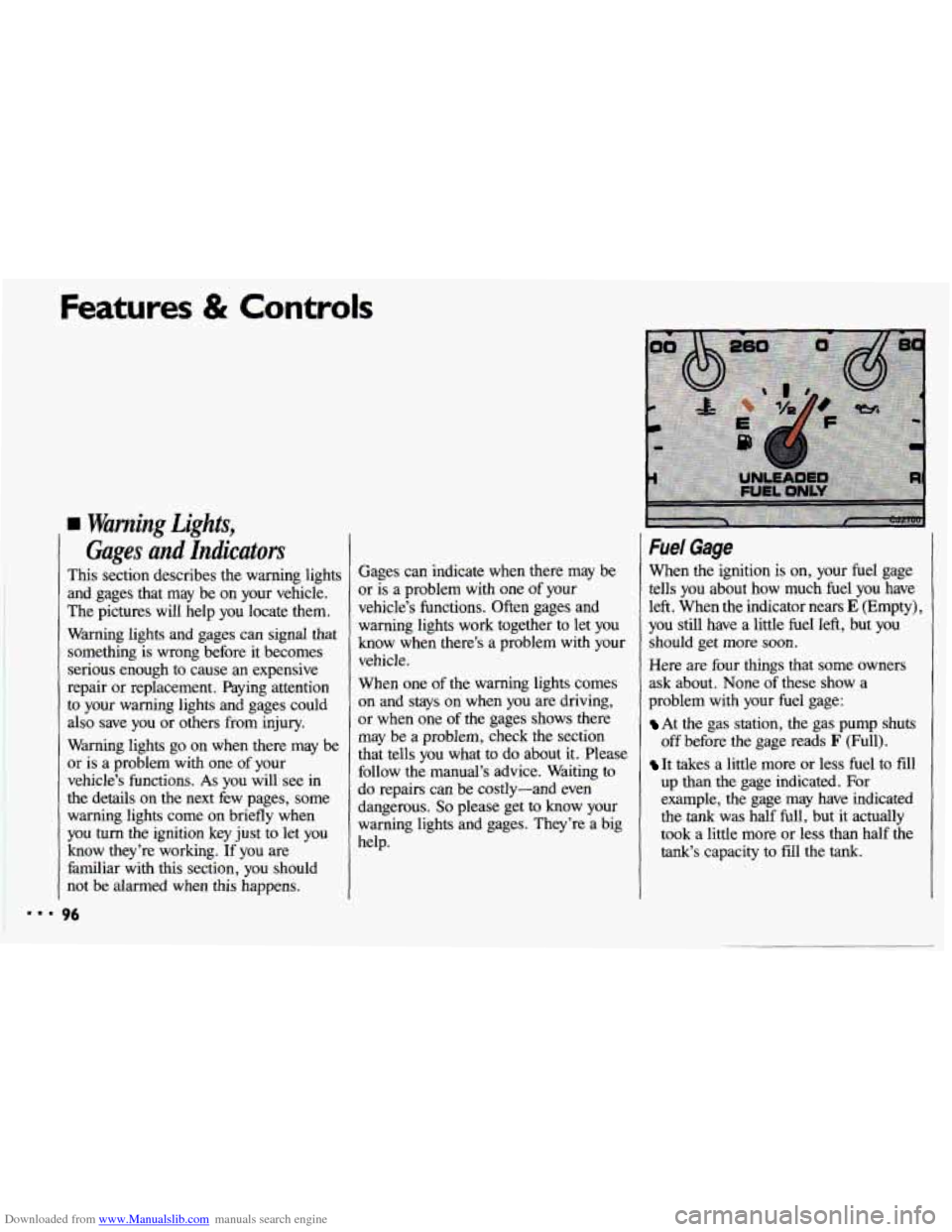
Downloaded from www.Manualslib.com manuals search engine Features & Controls
Warning Lights,
Gages and Indicators
This section describes the warning lights
and gages that may be on your vehicle.
The pictures will help
you locate them.
Warning lights and gages can signal that something is wrong before it becomes
serious enough
to cause an expensive
repair or replacement. Paying attention
to your warning lights and gages could also save you or others from injury.
Warning lights
go on when there may be
or is a problem
with one of your
vehicle’s functions.
As you will see in
the details on the next few pages, some
warning lights come on briefly when
you turn the ignition key just to let you
know they’re working. If you are
familiar with this section, you should
not be alarmed when this happens. Gages can indicate when there
may be
or is a problem with one
of your
vehicle’s functions. Often gages
and
warning lights work together to let you
know when there’s a problem with your
vehicle.
When one of the warning lights comes
on and stays on when you are driving,
or when one
of the gages shows there
may be a problem, check the section
that tells you what to do about it. Please
follow the manual’s advice. Waiting to
do repairs can be costly-and even
dangerous.
So please get to know your
warning lights and gages. They’re a big
help.
Fuel Gage
When the ignition is on, your fuel gage
tells
you about how much fuel you have
left. When the indicator nears
E (Empty),
you still have a little fuel left, but you
should get more soon.
Here are four things that some owners
ask about. None
of these show a
problem with your fuel gage:
At the gas station, the gas pump shuts
off before the gage reads
F (Full).
It takes a little more or less fuel to fdl
up than the gage indicated. For
example, the gage may have indicated
the
tank was half full, but it actually
took a little more or less than half the
tank‘s capacity to fill the tank.
Page 99 of 308
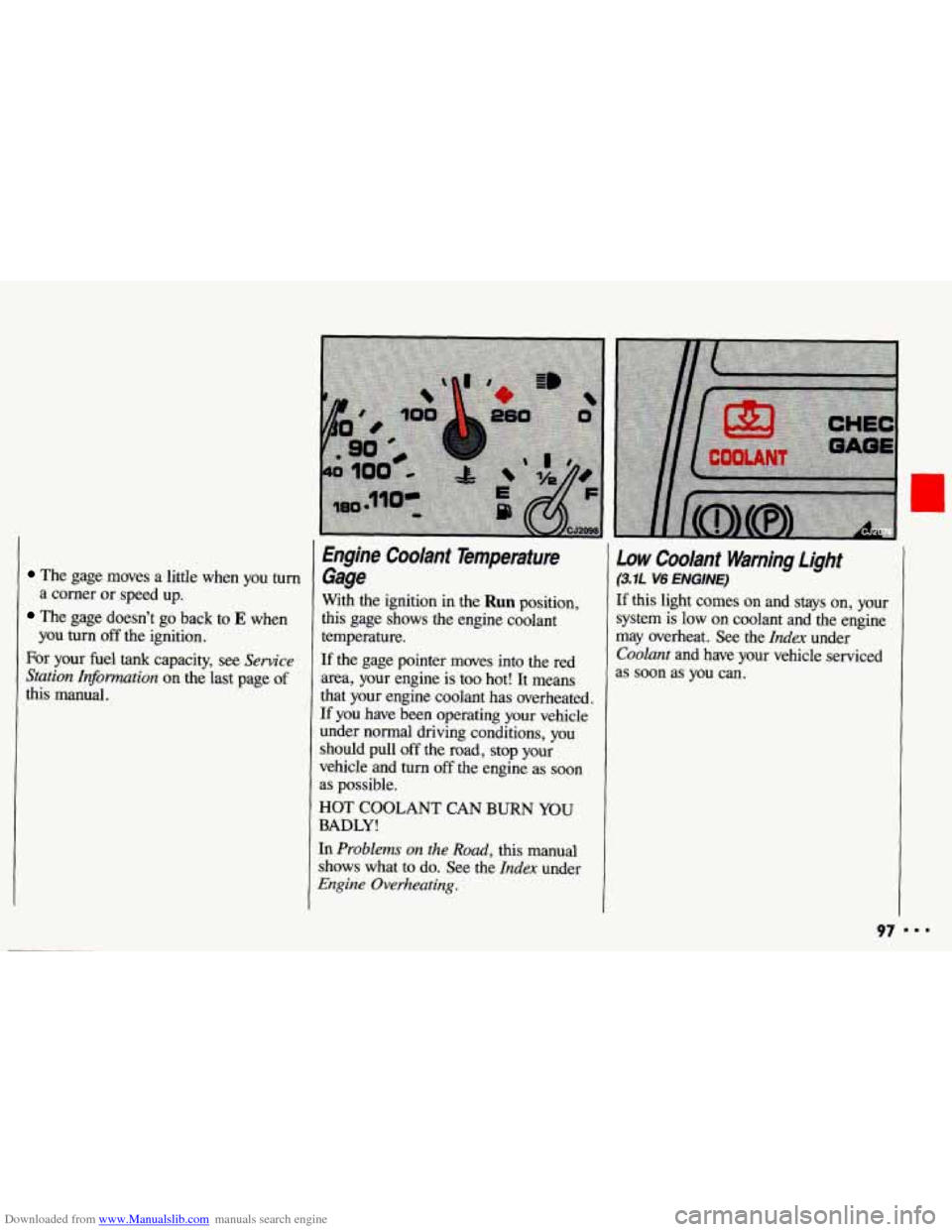
Downloaded from www.Manualslib.com manuals search engine The gage moves a little when you turn
The gage doesn’t go back to E when
For your fuel
tank capacity, see Service
Station Information
on the last page of
this manual. a
comer or speed up.
you
turn off the ignition.
Engine Coolant Temperature
Gage
With the ignition in the Run position,
this gage shows
the engine coolant
temperature.
If the gage pointer moves into the red
area, your engine is
too hot! It means
that your engine coolant has overheated.
If you have been operating your vehicle
under normal driving conditions, you
should pull
off the road, stop your
vehicle and turn
off the engine as soon
as possible.
HOT COOLANT CAN BURN YOU
BADLY!
In Problems on the Road, this manual
shows what to do. See the
Index under
Engine Overheating.
Law Coolant Warning Light
(3.7L V6 ENGiNE)
If this light comes on and stays on, your
system is low on coolant and the engine
may overheat. See the
Index under
Coolant and have your vehicle serviced
as soon as
you can.
97
Page 100 of 308

Downloaded from www.Manualslib.com manuals search engine Features & Controls
Oil Warning Light (3.7~ v6 ENGINE)
If you have a problem with your oil, this
light may stay on after you start your
engine, or come on when you are
driving. This indicates that oil is not
going through your engine quickly
enough to keep it lubricated. The engine
could be low on
oil, or could have some
other oil problem. Have it fixed right
away.
98
The oil light could also come on in three
other situations:
When the ignition is on but the engine
is
not running, the light will come on
as a test
to show you it is working, but
the light will
go out when you turn the
ignition to
Start. If it doesn’t come on
with the ignition on, you may have a
problem with the fuse or bulb. Have
it
fixed right away.
Sometimes when the engine is idling
at
a stop, the light may blink on and
off. This is normal.
If you make a hard stop, the light may
come
on for a moment. This is
normal. Don’t
keep driving
if the oil
b pressure is low. If you do,
your engine can become
so hot that
It catches fire. You or others could
be burned. Check your oil as soon
as possible and have your vehicle
serviced.
Damage to your engine
from
neglected oil problems can be
costly and
is not covered by YOL
warranty.
Page 102 of 308
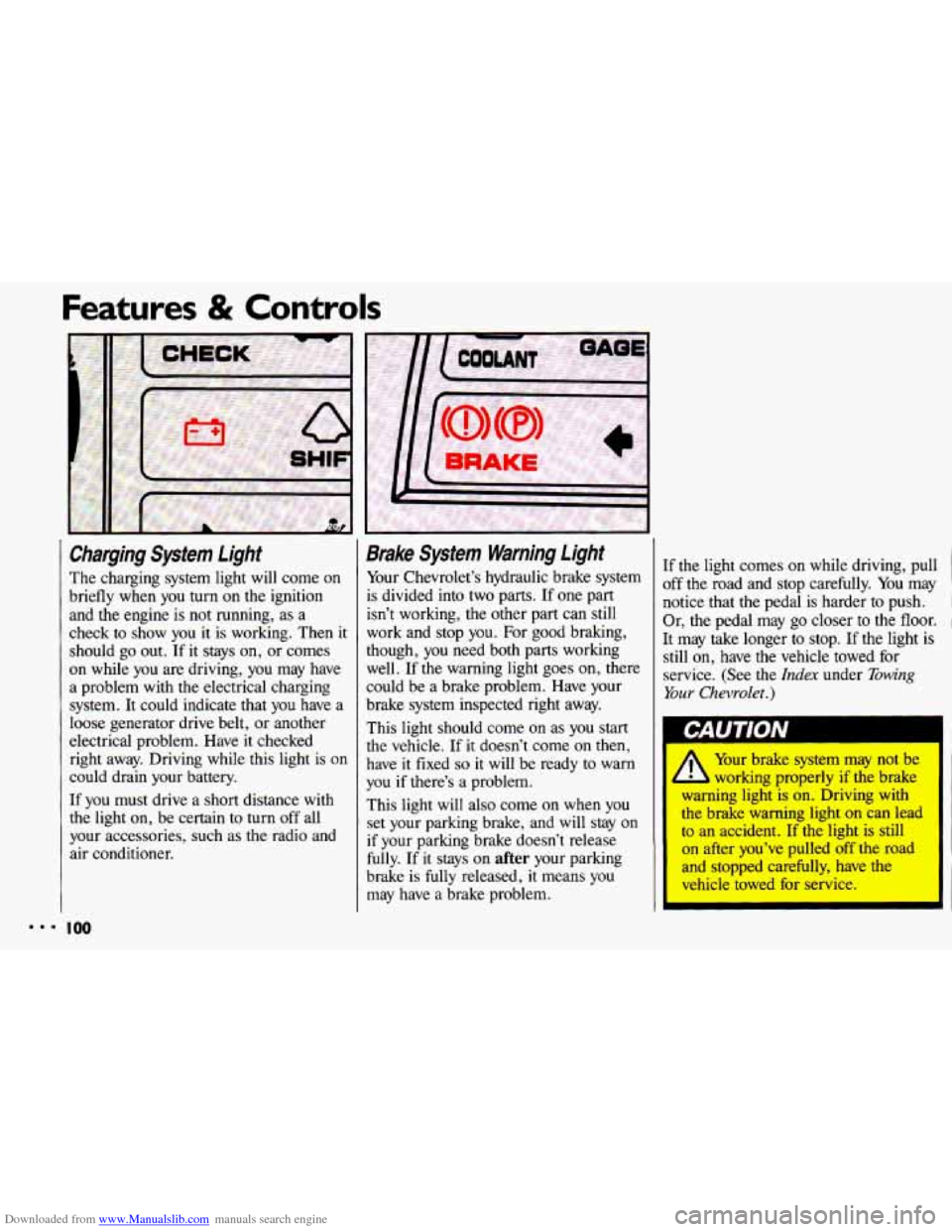
Downloaded from www.Manualslib.com manuals search engine Features & Controls
Charging System Light
The charging system light will come on
briefly when
you turn on the ignition
and the engine is not running, as a
check to show you it is working. Then it
should go out. If it stays on, or comes
on while you are driving, you may have
a problem with the electrical charging
system.
It could indicate that you have a
loose generator drive belt, or another
electrical problem. Have
it checked
right away. Driving while this light is on
could drain your battery.
If you must drive a short distance with
the light on, be certain to turn off all
your accessories, such as the radio and
air conditioner.
Brake Sysfem Warning Light
Your Chevrolet’s hydraulic brake system
is divided into two parts. If one part
isn’t working, the other part can still
work and stop you. For good braking,
though, you need both parts working
well. If the warning light goes on, there
could be a brake problem. Have your
brake system inspected right away.
This light should come on as you start
the vehicle. If it doesn’t come on then,
have
it fixed so it will be ready to warn
you if there’s
a problem.
This light will also come on when you
set your parking brake, and will stay
on
if your parking brake doesn’t release
fully. If it stays
on after your parking
brake is fully released,
it means you
may have
a brake problem. If
the light comes
on while driving, pull
off the road and stop carefully. You may
notice that the pedal is harder to push.
I
Or, the pedal may go closer to the floor. 1
It may take longer to stop. If the light is
still on, have the vehicle towed for
service. (See the
Index under Towing
Your Chevrolet.)
L-AU I IVN
I
/1 Your brake system may not be
L working properly if the brake
warning light is on. Driving with
the brake warning light
on can lead
to an accident. If the light is still
on after you’ve pulled off the road
and stopped carefully, have the
vehicle towed for service.
I
Page 103 of 308
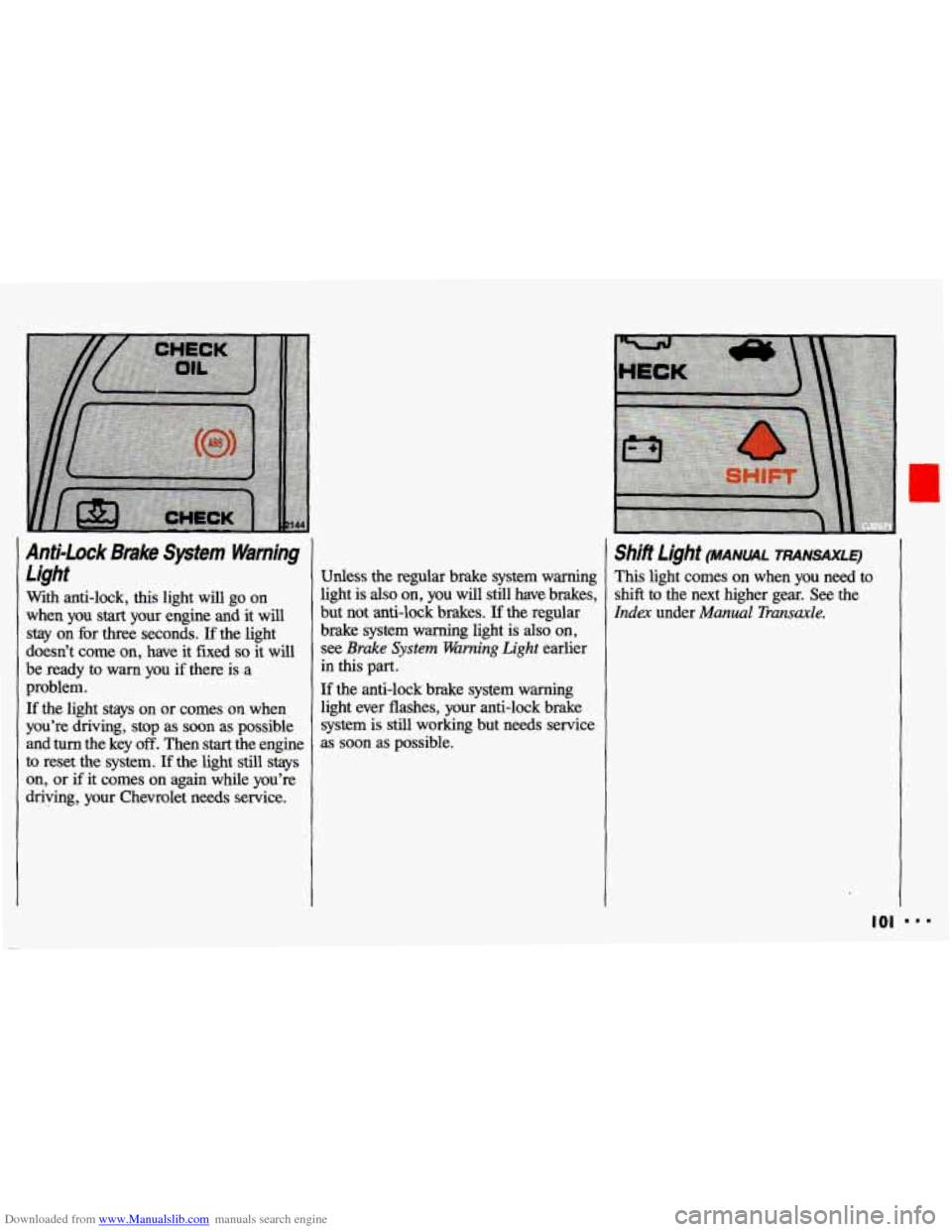
Downloaded from www.Manualslib.com manuals search engine Anti-Lock Brake System Warning
Light
With anti-lock, this light will go on
when you
start your engine and it will
stay on for three seconds.
If the light
doesn’t come on, have it fixed
so it will
be ready to warn you if there is a
problem.
If the light stays on or comes on when
you’re driving, stop as soon as possible
and turn the key
off. Then start the engine
to reset the system.
If the light still stays
on, or if it comes on again while you’re
driving, your Chevrolet
needs service.
Shift light (MANUAL TRANSAXLE)
Unless the regular brake system warning
brake system warning light is
also on,
Index under Manual Transale. but not anti-lock brakes. If the regular shift to the next higher gear. See
the
light is
also on, you will still have brakes, This
light comes on when you need to
in this part.
see Brake System Warning Light earlier
If the anti-lock brake system warning
light ever flashes, your anti-lock brake
system is still working but needs service
as soon as possible.
IO1
Page 105 of 308
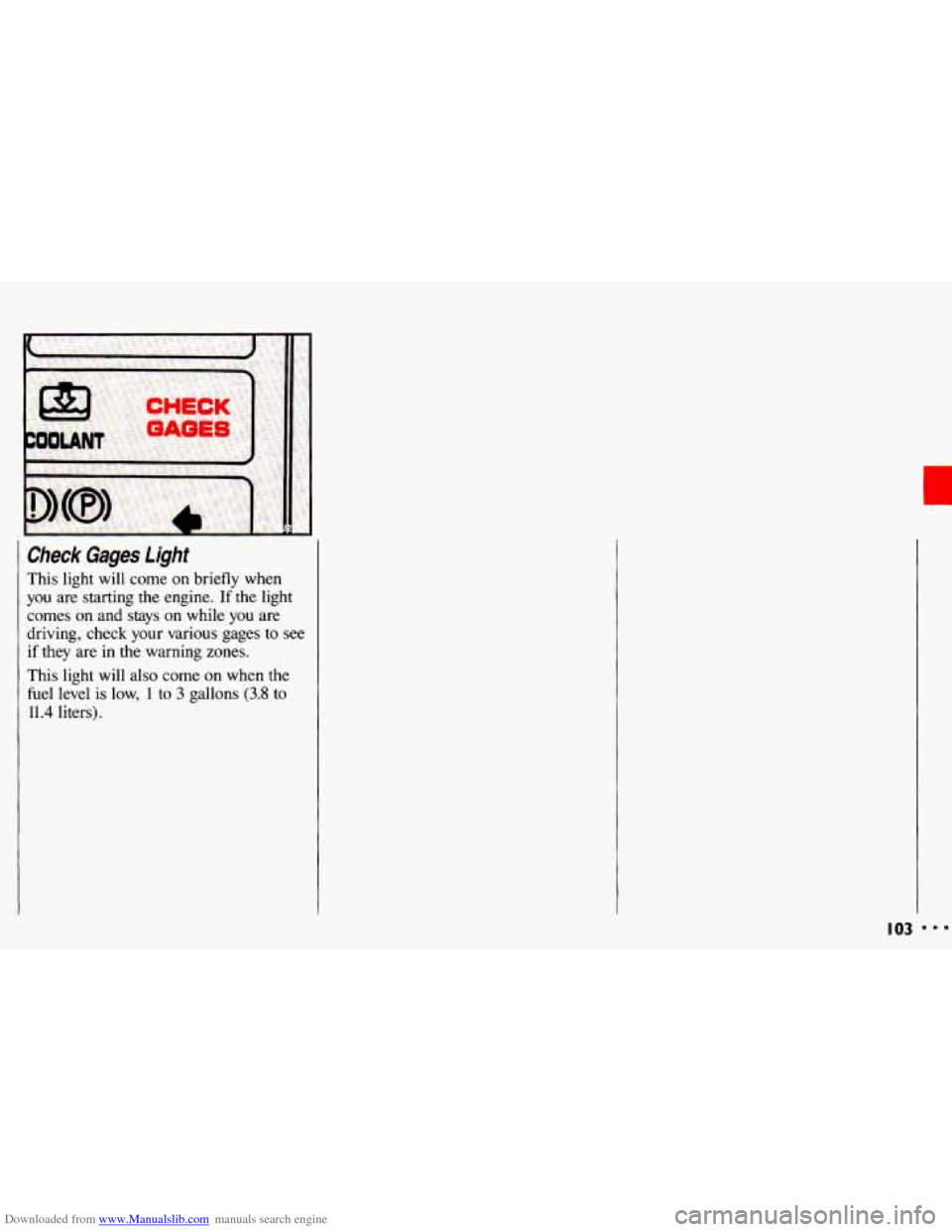
Downloaded from www.Manualslib.com manuals search engine Check Gages light
This light will come on briefly when
you are starting the engine. If the light
comes on
and stays on while you are
driving, check your various gages
to see
if they are in the warning zones.
This light will also come on when the
fuel level is low, 1 to 3 gallons (3.8 to
11.4 liters).
103
Page 129 of 308
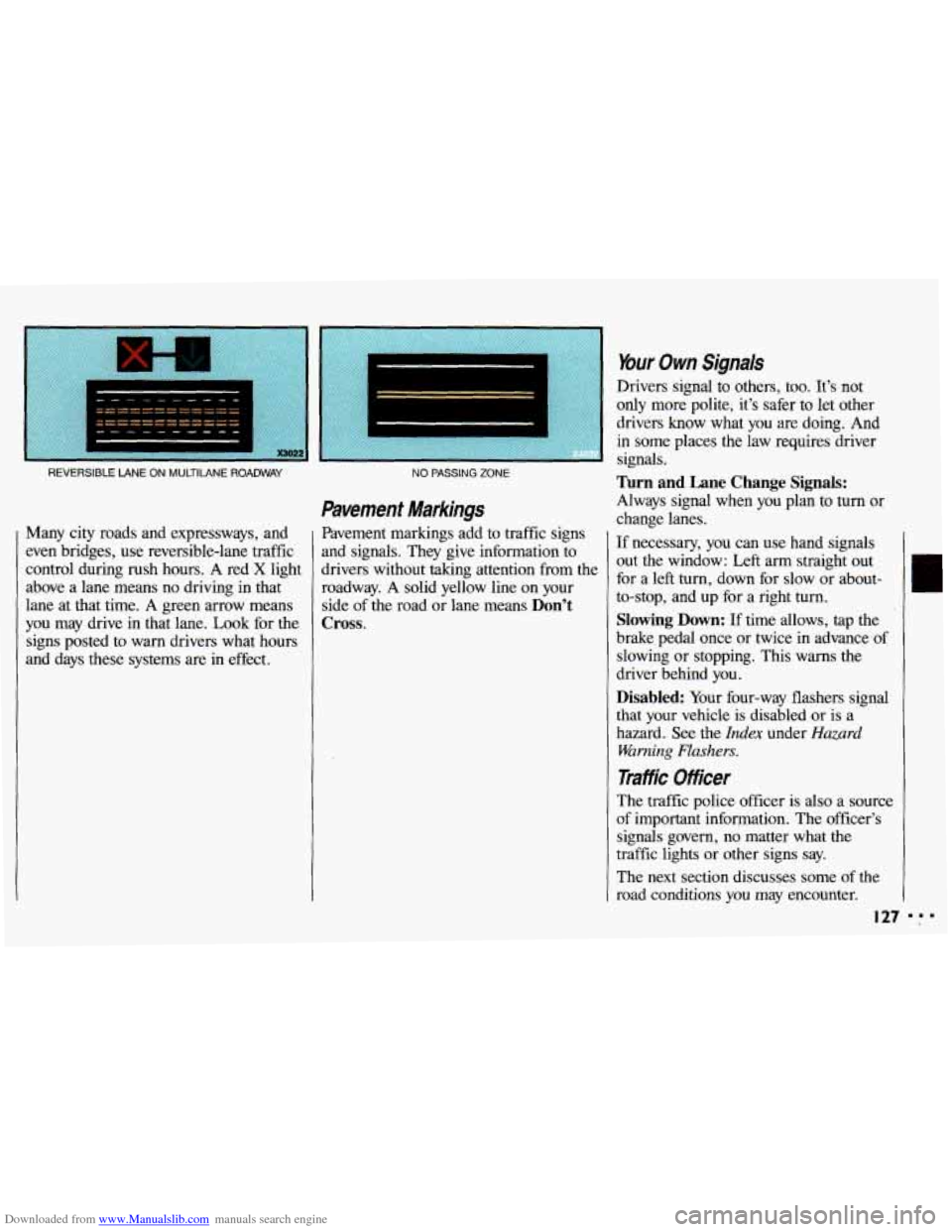
Downloaded from www.Manualslib.com manuals search engine REVERSIBLE LANE ON MULTILANE ROADWAY
Many city roads and expressways, and
even bridges, use reversible-lane traffic
control during rush hours. A red
X light
above
a lane means no driving in that
lane at that time. A green arrow means
you may drive in that lane.
Look for the
signs posted
to warn drivers what hours
and days these systems are in effect.
NO PASSING ZONE
Pavement Markings
Pavement markings add to traffic signs
and signals. They give information to
drivers without taking attention from the roadway.
A solid yellow line on your
side
of the road or lane means Don’t
Cross.
Mur Own Signals
Drivers signal to others, too. It’s not
only more polite, it’s safer
to let other
drivers
know what you are doing. And
in some places the law requires driver
signals.
Turn and Lane Change Signals:
Always signal when you plan to turn or
change lanes.
If necessary,
you can use hand signals
out the window: Left arm straight out for a left
turn, down for slow or about-
to-stop, and up for a right
turn.
Slowing Down: If time allows, tap the
brake pedal once or twice in advance of
slowing or stopping. This warns the
driver behind you.
Disabled: Your four-way flashers signal
that your vehicle is disabled or is a
hazard. See the
Index under Hazard
Warning Flashers.
Traffic Officer
The traffic police officer is also a source
of important information. The officer’s
signals govern, no matter what the
traffic lights or other signs say.
The next section discusses some
of the
road conditions
you may encounter.
I27
Page 136 of 308
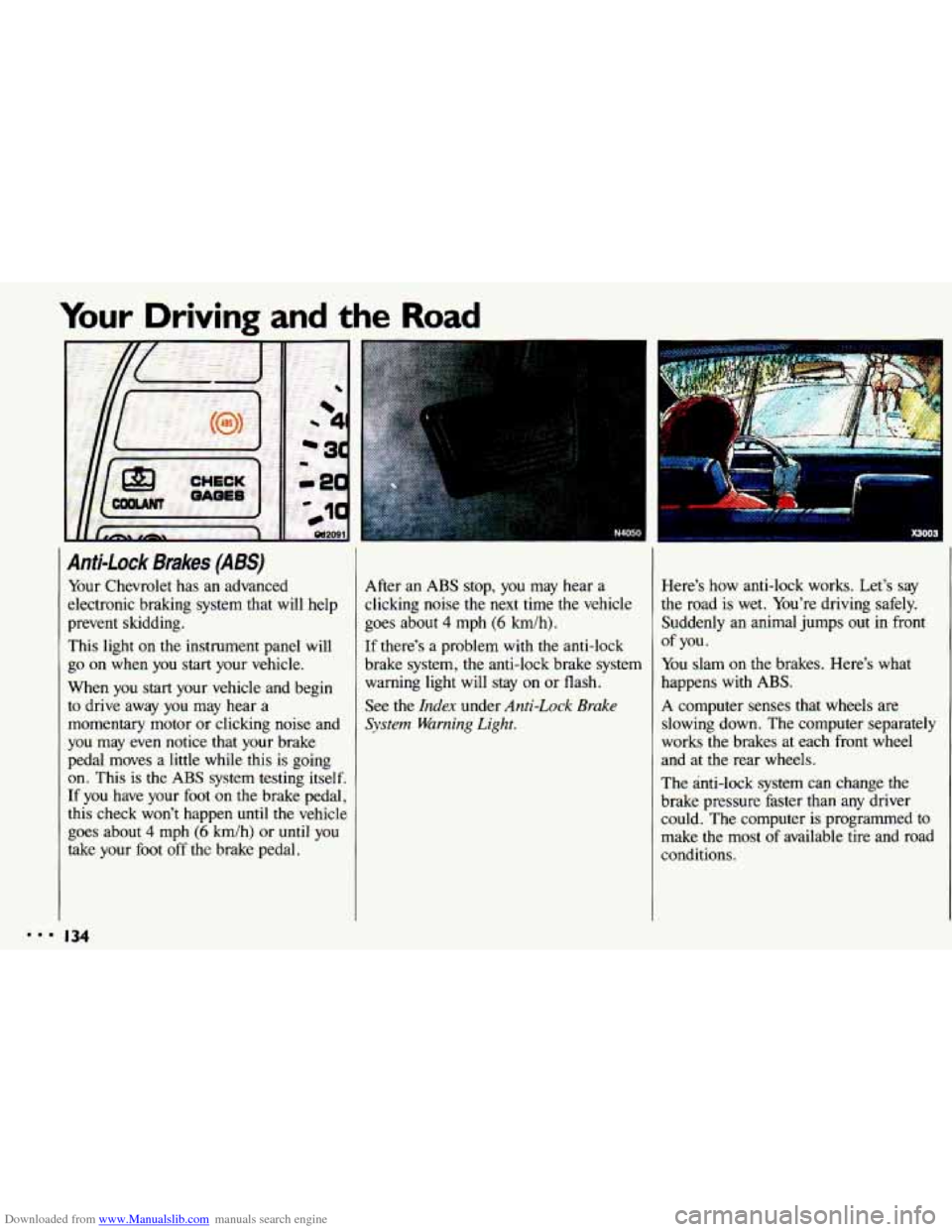
Downloaded from www.Manualslib.com manuals search engine Your Driving and the Road
Anti-Lock Brakes (ABS)
Your Chevrolet has an advanced
electronic braking system that will help
prevent skidding.
This light
on the instrument panel will
go
on when you start your vehicle.
When you start your vehicle and begin
to drive away you may hear a
momentary motor or clicking noise and
you may even notice that your brake
pedal moves a little while this is going
on. This is the ABS system testing itself.
If you have your foot on the brake pedal,
this check won’t happen
until the vehicle
goes about
4 mph (6 km/h) or until you
take your foot
off the brake pedal. After an
ABS stop,
you may hear a
clicking noise the next time the vehicle
goes about
4 mph (6 km/h).
If there’s a problem
with the anti-lock
brake system, the anti-lock brake system warning light will stay on or flash.
See
the Index under Anti-Lock Brake
System Warning Light.
Here’s how anti-lock works. Let’s say
the road is wet. You’re driving safely.
Suddenly an animal jumps out
in front
You slam
on the brakes. Here’s what
happens with ABS.
A computer senses that wheels are
slowing down. The computer separately
works the brakes at each front wheel
and at the rear wheels.
The anti-lock
system can change the
brake pressure faster than any driver
could. The computer is programmed to
make the most of available tire and road
conditions.
of you.
134